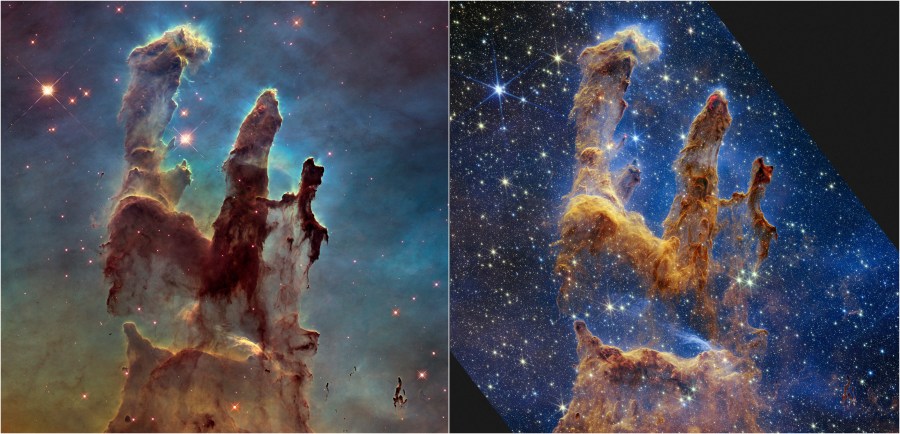James Webb telescope captures stunning image of Pillars of Creation: What to look for

(NEXSTAR) – The world was first mesmerized by the stellar view of cosmic pillars in 1995 thanks to the Hubble Space Telescope. Now, almost three decades later, NASA’s James Webb Space Telescope is giving us an even more stunning view.
Known as the Pillars of Creation, the dusty towers some 6,500 light-years away are regarded as a birthplace of stars.
According to NASA, the Pillars of Creation are just a fraction of a star-forming region within the Eagle Nebula, which was discovered in 1745 by Swiss astronomer Jean-Philippe Loys de Chéseaux.
Hidden within the columns are newborn stars, some of which can be seen in the newest image from the James Webb telescope.
Side-by-side images of the Pillars of Creation, as seen by Hubble (on the left) and Webb (on the right), can be viewed below. Webb’s Near-Infrared Camera was able to capture an even more detailed view than Hubble, offering a better glimpse of the newborn stars.

The red orbs seen in Webb’s version will, eventually, collapse under their own gravity, heat up, and form new stars, NASA explains. Stars that are still forming create the lava-like lines on the edges of the columns.
When new stars are forming, NASA explains that they can sometimes shoot out supersonic jets that collide with other material. This can lead to bow shocks, leaving wavy patterns. This also creates energetic hydrogen molecules, causing the crimson glow.
The young stars pictured above are estimated to be a few hundred thousand years old — relatively young in the lifespan of stars. NASA will use Webb’s newest image to better understand star formation.
You don’t need an expensive space telescope to view the Eagle Nebula, either. According to NASA, the nebula can be best viewed in July with even a small telescope. A larger telescope and even better viewing conditions can offer a glimpse at the Pillars of Creation.
Copyright 2023 Nexstar Media Inc. All rights reserved. This material may not be published, broadcast, rewritten, or redistributed. Regular the hill posts











